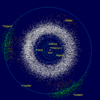Wikipedia:Today's featured article/May 27, 2010
The Jupiter Trojans are a large group of objects that share the orbit of the planet Jupiter around the Sun. Relative to Jupiter, each Trojan librates around one of the planet's two Lagrangian points of stability, L4 and L5, that respectively lie 60° ahead of and behind the planet in its orbit. Trojan asteroids are distributed in two elongated, curved regions around these Lagrangian points with an average semi-major axis of about 5.2 AU. The first Trojan, 588 Achilles, was discovered in 1906 by the German astronomer Max Wolf. A total of 2,909 Jupiter Trojans have been found as of January 2009[update]. The name "Trojans" derives from the fact that, by convention, they each are named after a mythological figure from the Trojan War. The total number of Jupiter Trojans larger than 1 km is believed to be about 1 million, approximately equal to the number of asteroids larger than 1 km in the main asteroid belt. Like main belt asteroids, Trojans form families. Jupiter Trojans are dark bodies with reddish, featureless spectra. No firm evidence of the presence of water, organic matter or other chemical compounds has been obtained. The Trojans' densities (as measured by studying binaries or rotational lightcurves) vary from 0.8 to 2.5 g·cm−3. Trojans are thought to have been captured into their orbits during the early stages of the Solar System's formation or slightly later, during the migration of giant planets. (more...)
Recently featured: John Churchill, 1st Duke of Marlborough – Victoria Cross – "The Beginning of the End"

